New In-Flame Flammability Testing Method Applied to Monitor Seasonal Changes in Live Fuel
Abstract
:1. Introduction
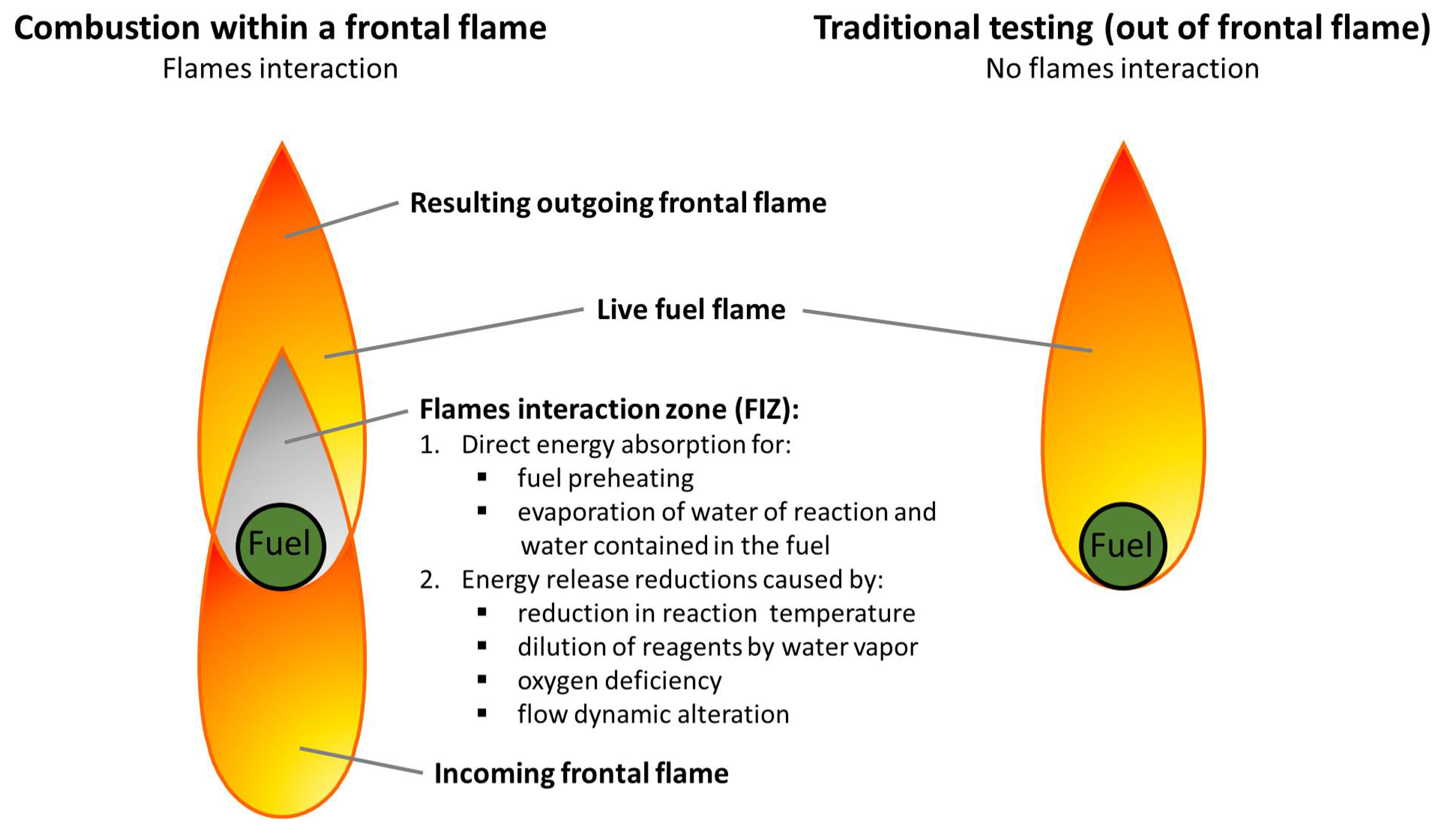
2. Materials and Methods
2.1. Fuel Element’s Energy Release Contribution to the Incoming Frontal Flame
2.2. Fuel Samples
2.3. Field Sampling
2.4. Test Sequence
2.5. Biophysical Characteristics
3. Results and Discussion
3.1. Heat Transfer
| Figure 2 | Fire Type | Flame Length (m) | Flame- Front Residence Time (s) | Total Heat Transfer (kW m−2) | Peak Convective Heat Transfer | Peak Radiative Heat Transfer | Location, Fire Name | Source | ||
|---|---|---|---|---|---|---|---|---|---|---|
| kW m−2 | % | kW m−2 | % | |||||||
| Needle cast | Surface | 30 | 37 | [71] | ||||||
| Mixed grasses, needle cast | Surface | 0.83 | 42 | 22 | 20 | Rombo 1 | [55] | |||
| Surface | 0.39 | 4 | 13 | 24 | Eglin 2 | [55] | ||||
| Surface | 1.59 | 12 | 107 | 115 | Ichauway 1 | [55] | ||||
| Surface | 082 | 9 | 100 | 105 | Ichauway 2 | [55] | ||||
| Surface | 0.84 | 22 | 140 | 90 | Ichauway 3 | [55] | ||||
| Surface | 1.25 | 11 | 82 | 59 | Ichauway 4 | [55] | ||||
| Shrubs, scrubs | 30–120 | 40–50 | Mediterranean | [71] | ||||||
| 112 | 51 | [72] | ||||||||
| Mixed | 6.5 | 21 | 113 | 51 | 45 | Experiment 1 | [73] | |||
| Mixed | 6.8 | 31 | 120 | 62 | 52 | Experiment 2 | [73] | |||
| Mixed | 8.4 | 27 | 110 | 50 | 45 | Experiment 3 | [73] | |||
| Mixed | 5.1 | 25 | 83 | 36 | 43 | Experiment 4 | [73] | |||
| Mixed | 6.1 | 26 | 101 | 34 | 34 | Experiment 5 | [73] | |||
| Needle cast, grass, shrubs, brush, or sagebrush | Surface | 1.25 | 17 | 60 | 75 | Eglin 1 | [55] | |||
| Brush | 2.4 | 40 | 94 | 130 | Rombo 2 | [55] | ||||
| Brush | 1.44 | 10 | 26 | 120 | Leadore 1 | [55] | ||||
| Brush | 1.44 | 10 | 19 | 132 | Leadore 2 | [55] | ||||
| 105–120 | 30–60 | [71] | ||||||||
| 32–42 | 100–120 | 25–50 | [71] | |||||||
| Forest | Crown | 30 | 42 | 300 | Rat Creek | [55] | ||||
| Crown | 20 | 50 | 32 | 189 | Mill Creek | [55] | ||||
| Crown | 37 | 120–300 | [71] | |||||||
3.2. Energy Release Reductions
3.3. Flammability Definition and Numerical Fuel Classification
3.4. Energy Balance
3.5. Stand-Scale Flammability
3.6. Seasonal Variation and Drivers of Flammability
3.7. Limitations and Future Research
4. Conclusions
Author Contributions
Funding
Data Availability Statement
Acknowledgments
Conflicts of Interest
Nomenclature
| Energy-related variables and definitions | |
| H | Heat of combustion, dry mass basis (kJ g−1) |
| Hgross | Gross heat of combustion, dry mass basis (calorific content) (kJ g−1) |
| EC | Energy content, equivalent to Hgross expressed on fresh mass basis (kJ g−1) |
| Heff | Effective heat of combustion, mass loss basis (kJ g−1) |
| ∆e+ | Flammability as fuel element’s contribution to the energy release of the incoming flame, per fuel element/sample (kJ) |
| ∂Heff | Flammability as differential effective heat of combustion, which represents ∆e+ per unit fresh mass or mass loss of fuel element/sample (kJ g−1) |
| Other variables and definitions | |
| DM | Dry matter content, fresh mass basis (%) |
| FIZ | Flames interaction zone |
| FMC | Foliar moisture content, dry mass basis (%) |
| Shoots | Twigs/branchwood 0–9 mm thick with the attached foliage |
| SWCfm | Shoot water content, fresh mass basis (%) |
| SWCdm | Shoot water content, dry mass basis (analogous to FMC, but for shoots instead of foliage alone) (%) |
| SWCvol | Shoot water content, volume basis (g cm−3) |
Appendix A. Additional Figures
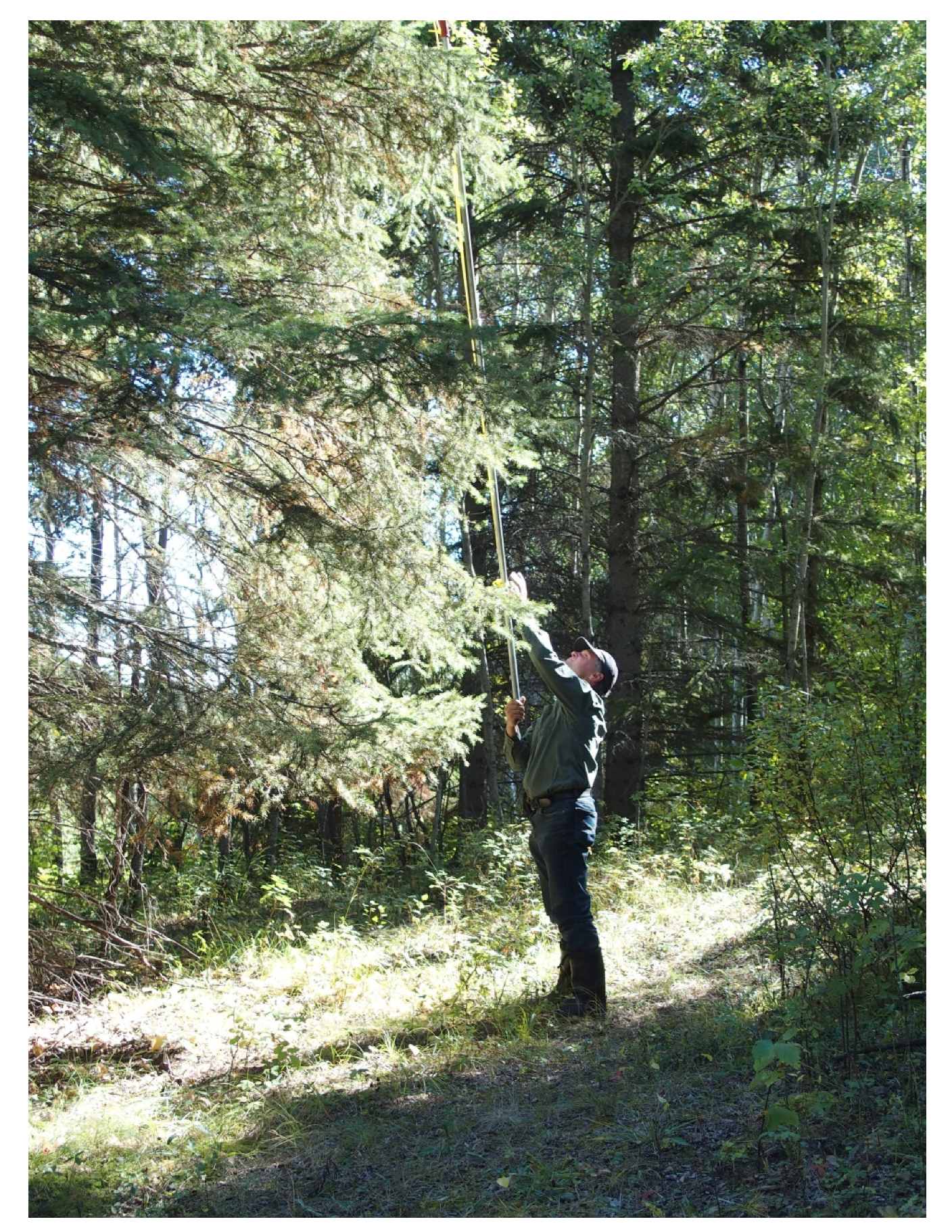
Appendix B. Historical Seasonality of Extreme Crown Fire Behavior in Canada

| Wildfire Name and Location | Year | Start Date | End Date | Size (ha) | Human Lives Lost | Evacuated | Reference |
|---|---|---|---|---|---|---|---|
| Great Miramichi Fire, NB | 1825 | 7 October | - | 1,200,000 | 160+ (500+ unofficially) | [80] | |
| Saguenay–Lac-Saint-Jean Fire, QC | 1870 | 19 May | 19 May/27 May | 400,000 | 7 | [80,81] | |
| The Great Fire, Ottawa Valley, ON | 1870 | 1 August | 28 August | 51,200+ | 20+ | 8000+ | [81] |
| Fernie Fire, BC | 1908 | 1 August | 1 August | 25,900 | 22+ | [80] | |
| Baudette Fire/Rainy River Fire, MN and ON | 1910 | 7 October | 7 October | 121,500 | 42+ | [80] | |
| Great Porcupine Fire, AB and ON | 1911 | 11 July | 11 July | 200,000/ 804,650 | 73+ (in the hundreds unofficially) | 200 | [80,82] |
| Great Matheson Fire, AB and ON | 1916 | 29 July | 3 August/29 July | 200,000 | 223+ (as high as 400 unofficially) | 8000 | [80,82] |
| Lac La Biche Fire, AB and SK | 1919 | 19 May | Early June | 2,800,000 | 13+ | [80,83] | |
| Great Fire of 1922 Haileybury, ON | 1922 | 30 September | 5 October | 168,000/ 518,000 | 43+ (as high as 150 unofficially) | 11,000 | [80,82] |
| Rainy River and Dance Township Fire, ON | 1938 | 10 October | 15 October | 30,355/ 37,230 | 17+ | 155 | [80,82] |
| Gogama, ON | 1941 | 14 May | 15 June | 133,827 | [82] | ||
| Mississagi, ON | 1948 | 1 May | 31 October | 261,017 | [82] | ||
| Chinchaga River Fire (Wisp fire), BC and AB | 1950 | Major run 20 September | October | 1,400,000 | [87] | ||
| Lesser Slave Lake Fire, AB | 1968 | Major run 23 May | 133,550 | [98] | |||
| Vega fire, AB | 1968 | 23 May | [90] | ||||
| Inuvik Fire, NWT | 1968 | 8 August | 18 August | 35,000 | [89] | ||
| Cold Lake Fire (DND-3-80), AB and SK | 1980 | 1 May | [98] | ||||
| Cold Lake Fire (DND-4-80) AB and SK | 1980 | 2 May | 177,813 | [98] | |||
| Hay River Fire (HY-36-81), NWT | 1981 | 3 July | 1009 | [91] | |||
| Red Lake Fire, ON | 1980 | 1 June | 43,664 | 5000 | [82] | ||
| Fire Northeast of Vancouver, BC | 1985 | 1 July | 240,000+ | [82] | |||
| Northern Manitoba fires | 1989 | 11 May | 20 September | 3,280,000 | 25,000 | [82,84] | |
| Betsiamites, Ragueneau and Baie-Comeau Fire, QC | 1991 | 29 June | 29 June | 7000 | [82] | ||
| North Central Saskatchewan fires | 1995 | 29 May | 29 May | 160,000 | 3338 | [82] | |
| Swan Hills Fire, AB | 1998 | 5 May | 21 May | 155,000 | 2030 | [82] | |
| Tibbet Lake Fire, NWT | 1998 | 22 July | 31 July | 140,000 | 5 | [82] | |
| British Columbia fires | 1998 | 1 August | 31 August? | 42,115 | 10,600 | [82] | |
| Salmon Arm Fire, BC | 1998 | 10 August | 17 August | 6300 | 7000 | [82] | |
| Chisholm fire (LWF-063), AB | 2001 | 23 May | 29 May | 36,690 | [90] | ||
| House River Fire, AB | 2002 | 17 May | 7 June | 248,000/ 248,243 | 1550 | [82,92] | |
| Manitoba fires | 2003 | 1 April | 31 October | 918,845 | 665 | [82,85] | |
| Southeastern BC and Southwestern AB fires | 2003 | 1 July | 31 August | 48,501 | [82] | ||
| Okanagan Mountain Park Fire, BC | 2003 | 16 August | 12 September | 25,000/ 25,600 | 27,000/ 33,050 | [94]/ [86] | |
| McLure Fire, BC | 2003 | 30 July | October | 26,420/ 26,000 | 3800 | [86]/ [93] | |
| Mistissini Fire, QC | 2006 | 16 June | 18 June | 3200 | [82] | ||
| Tumbler Ridge Fire, BC | 2006 | 3 July | 5 July | 9100 | 4000 | [82] | |
| South Indian Lake Fire, MB | 2007 | 19 July | 26 July | 147,473 | 963 | [82] | |
| Norway House and Sherridon Fire, MB | 2008 | 28 May | 28 May | 3330 | [82] | ||
| Halifax Fire, NS | 2008 | 13 June | 13 June | 5000 | [82] | ||
| Northern Saskatchewan fires | 2008 | 30 June | 30 June | 2500 | [82] | ||
| Kelowna, Kamloops and Cariboo Fire, BC | 2009 | 1 May | 31 August | 1 | 20,000 | [82] | |
| West Kelowna wildfires, BC | 2009 | 18 July | 31 August | [82] | |||
| British Columbia fires | 2010 | 28 July | 8 September | 330,000 | 2 | 1383 | [82] |
| British Columbia fires | 2010 | 18 August (2nd major run) | Early September | [86] | |||
| Richardson Backcountry Fire, AB | 2011 | 15 May | September | 148,000+ | [95] | ||
| Slave Lake Wildfire, AB | 2011 | 14 May | 22 May | 4900 | 1 | 12,055 | [82] |
| Northern Ontario fires | 2011 | 6 July | 25 July | 300,000 | 3300+ | [82] | |
| Mackenzie County Fire, AB | 2012 | 11 July | 20 July | 100,000 | 300 | [82,99] | |
| Lethbridge and Coalhurst Fire, AB | 2012 | 10 September | 11 September | 3000 | [82] | ||
| Northwest Territories fires | 2014 | 1 July | 18 September | 3,500,000+ | 60 | [82] | |
| British Columbia fires | 2014 | 1 July | 30 September | 360,000 | 4500 | [82] | |
| British Columbia fires | 2015 | 9 May | 11 September | 300,000 | 1 | 3432 | [82] |
| Northern Saskatchewan fires | 2015 | 1 July | 18 July | 1,800,000 | 13,000 | [82] | |
| Peace Region fires, BC | 2016 | 18 April | Fall | [86] | |||
| Wood Buffalo (Fort McMurray) Wildfire, AB and SK | 2016 | 1 May/30 April | Mid June/ 1 June | 589,000/ 593,670 | 2 | 88,000/96,000 | [100]/[82] |
| Easterville and Chemawawin Fire, MB | 2016 | 23 June | 27 June | 2070 | [82] | ||
| British Columbia fires | 2017 | 7 July | 15 September | 1,200,000+ | 65,000 | [86] | |
| Verdant Creek Fire, BC | 2017 | 15 July | October | 18,017 | [97] | ||
| Kenow Fire, AB | 2017 | 30 August | 38,000 | [96] |
References
- Countryman, C.M. The Fire Environment Concept; USDA Forest Service, Pacific Southwest Forest and Range Experiment Station: Berkeley, CA, USA, 1972. Available online: https://www.frames.gov/catalog/8189 (accessed on 3 July 2021).
- Finney, M.A.; Cohen, J.D.; McAllister, S.S.; Jolly, W.M. On the need for a theory of wildland fire spread. Int. J. Wildland Fire 2012, 22, 25–36. [Google Scholar] [CrossRef] [Green Version]
- Pimont, F.; Ruffault, J.; Martin-StPaul, N.K.; Dupuy, J.L. Why is the effect of live fuel moisture content on fire rate of spread underestimated in field experiments in shrublands? Int. J. Wildland Fire 2019, 28, 127–137. [Google Scholar] [CrossRef]
- Whitman, E.; Parisien, M.A.; Thompson, D.K.; Hall, R.J.; Skakun, R.S.; Flannigan, M.D. Variability and drivers of burn severity in the northwestern Canadian boreal forest. Ecosphere 2018, 9, e02128. [Google Scholar] [CrossRef] [Green Version]
- Stocks, B.J. Fire behavior in immature jack pine. Can. J. For. Res. 1987, 17, 80–86. [Google Scholar] [CrossRef]
- Call, P.; Albini, F. Aerial and surface fuel consumption in crown fires. Int. J. Wildland Fire 1997, 7, 259–264. [Google Scholar] [CrossRef] [Green Version]
- Melnik, O.M. A Proposed Experimental Methodology for Assessing the Effects of Biophysical Properties and Energy Content on Live Fuel Flammability. Master’s Thesis, University of Alberta, Edmonton, AB, Canada, 2016. [Google Scholar] [CrossRef]
- Stocks, B.J.; Alexander, M.E.; Wotton, B.M.; Stefner, C.N.; Flannigan, M.D.; Taylor, S.W.; Lavoie, N.; Mason, J.A.; Hartley, G.R.; Maffey, M.E.; et al. Crown fire behaviour in a northern jack pine—Black spruce forest. Can. J. For. Res. 2004, 34, 1548–1560. [Google Scholar] [CrossRef] [Green Version]
- Flannigan, M.D.; Wotton, B.M.; Marshall, G.A.; de Groot, W.J.; Johnston, J.; Jurko, N.; Cantin, A.S. Fuel moisture sensitivity to temperature and precipitation: Climate change implications. Clim. Change 2016, 134, 59–71. [Google Scholar] [CrossRef]
- de Groot, W.J.; Flannigan, M.D.; Cantin, A.S. Climate change impacts on future boreal fire regimes. For. Ecol. Manag. 2013, 294, 35–44. [Google Scholar] [CrossRef]
- Anderson, H.E. Forest fuel ignitibility. Fire Technol. 1970, 6, 312–319. [Google Scholar] [CrossRef]
- Martin, R.E.; Gordon, D.A.; Gutierrez, M.E.; Lee, D.S.; Molina, D.M.; Schroeder, R.A.; Sapsis, D.B.; Stephens, S.L.; Chambers, M. Assessing the flammability of domestic and wildland vegetation. In Proceedings of the International Conference on Fire and Forest Meteorology, Jekyll Island, GA, USA, 26–28 October 1993; Volume 12, pp. 130–137. [Google Scholar]
- Littell, J.S.; Peterson, D.L.; Riley, K.L.; Liu, Y.; Luce, C.H. A review of the relationships between drought and forest fire in the United States. Glob. Change Biol. 2016, 22, 2353–2369. [Google Scholar] [CrossRef]
- Stocker, O. Das Wasserdefizit von Gefässpflanzen in verschiedenen Klimazonen. Planta 1929, 7, 382–387. [Google Scholar] [CrossRef]
- Weatherley, P. Studies in the water relations of the cotton plant. I. The field measurement of water deficits in leaves. New Phytol. 1950, 49, 81–97. [Google Scholar] [CrossRef]
- Blanch, J.S.; Peñuelas, J.; Sardans, J.; Llusià, J. Drought, warming and soil fertilization effects on leaf volatile terpene concentrations in Pinus halepensis and Quercus ilex. Acta Physiol. Plant. 2009, 31, 207–218. [Google Scholar] [CrossRef]
- Van Wagner, C.E. Flammability of Christmas Trees; Department of Forestry: Ottawa, ON, Canada, 1963. Available online: https://cfs.nrcan.gc.ca/pubwarehouse/pdfs/24636.pdf (accessed on 3 July 2021).
- Babrauskas, V. Effective heat of combustion for flaming combustion of conifers. Can. J. For. Res. 2006, 36, 659–663. [Google Scholar] [CrossRef]
- Owens, M.; Lin, C.; Taylor, C.; Whisenant, S. Seasonal patterns of plant flammability and monoterpenoid content in Juniperus ashei. J. Chem. Ecol. 1998, 24, 2115–2129. [Google Scholar] [CrossRef]
- May, N.; Ellicott, E.; Gollner, M. An examination of fuel moisture, energy release and emissions during laboratory burning of live wildland fuels. Int. J. Wildland Fire 2019, 28, 187–197. [Google Scholar] [CrossRef]
- de Groot, W.J. Interpreting the Canadian forest fire weather index (FWI) system. In Proceedings of the Fourth Central Regional Fire Weather Committee Scientific and Technical Seminar; Canadian Forest Service: Edmonton, AB, Canada, 1987; pp. 3–14. [Google Scholar]
- Canadell, J.; Jackson, R.B.; Ehleringer, J.B.; Mooney, H.A.; Sala, O.E.; Schulze, E.D. Maximum rooting depth of vegetation types at the global scale. Oecologia 1996, 108, 583–595. [Google Scholar] [CrossRef] [PubMed]
- NFDRS. Appendix E. NFDRS Technical Reference. In WIMS User Guide; U.S. Department of Agriculture, Forest Service: Ogden, UT, USA, 2011. Available online: https://famit.nwcg.gov/sites/default/files/Appx_E_NFDRS_Technical_Reference.pdf (accessed on 3 July 2021).
- Johnston, D.C.; Turetsky, M.R.; Benscoter, B.W.; Wotton, B.M. Fuel load, structure, and potential fire behaviour in black spruce bogs. Can. J. For. Res. 2015, 45, 888–899. [Google Scholar] [CrossRef]
- Rivera, J.D.; Davies, G.M.; Jahn, W. Flammability and the Heat of Combustion of Natural Fuels: A Review. Combust. Sci. Technol. 2012, 184, 224–242. [Google Scholar] [CrossRef]
- Philpot, C.W. The Moisture Content of Ponderosa Pine and Whiteleaf Manzanita Foliage in the Central Sierra Nevada; Res. Note PSW-RN-039; Department of Agriculture, Forest Service, Pacific Southwest Forest and Range Experiment Station: Berkeley, CA, USA, 1963; Volume 39, 7p.
- McAllister, S.; Grenfell, I.; Hadlow, A.; Jolly, W.M.; Finney, M.; Cohen, J. Piloted ignition of live forest fuels. Fire Saf. J. 2012, 51, 133–142. [Google Scholar] [CrossRef]
- Page, W.G.; Jenkins, M.J.; Runyon, J.B. Mountain pine beetle attack alters the chemistry and flammability of lodgepole pine foliage. Can. J. For. Res. 2012, 42, 1631–1647. [Google Scholar] [CrossRef] [Green Version]
- Jolly, W.M.; Hintz, J.; Kropp, R.C.; Conrad, E.T. Physiological drivers of the live foliar moisture content ‘spring dip’ in Pinus resinosa and Pinus banksiana and their relationship to foliar flammability. In Proceedings of the VII International Conference on Forest Fire Research, Coimbra, Portugal, 17–20 November 2014; pp. 1–9. Available online: http://www.lakestatesfiresci.net/docs/Jolly_et_al_Spring_Dip_Physiology_15Jul2014.pdf (accessed on 3 July 2021).
- Pausas, J.G.; Alessio, G.A.; Moreira, B.; Segarra-Moragues, J.G. Secondary compounds enhance flammability in a Mediterranean plant. Oecologia 2016, 180, 103–110. [Google Scholar] [CrossRef] [Green Version]
- Van Wagner, C.E. Conditions for the start and spread of crown fire. Can. J. For. Res. 1977, 7, 23–34. [Google Scholar] [CrossRef]
- Beck, J.A.; Parminter, J.; Alexander, M.E.; MacDermid, E.; Van Nest, T.A.; Beaver, A.K.; Grimaldi, S. Fire ecology and management. In Forestry Handbook for British Columbia; University of British Columbia: Vancouver, BC, Canada, 2005; pp. 489–525. Available online: https://cfs.nrcan.gc.ca/publications?id=25580 (accessed on 3 July 2021).
- Van Wagner, C.E. A Spread Index for Crown Fires in Spring; Canadian Forestry Service, Petawa Forest Experiment Station: Chalk River, ON, Canada, 1974. Available online: https://cfs.nrcan.gc.ca/pubwarehouse/pdfs/23603.pdf (accessed on 3 July 2021).
- Alexander, M.E.; Cruz, M.G. Assessing the effect of foliar moisture on the spread rate of crown fires. Int. J. Wildland Fire 2013, 22, 415–427. [Google Scholar] [CrossRef]
- Rossa, C.G.; Fernandes, P.M. Live Fuel Moisture Content: The ‘Pea Under the Mattress’ of Fire Spread Rate Modeling? Fire 2018, 1, 43. [Google Scholar] [CrossRef] [Green Version]
- Fons, W.L. Analysis of fire spread in light fuels. J. Agric. Res. 1946, 72, 93–121. [Google Scholar]
- Babrauskas, V.; Peacock, R.D. Heat release rate: The single most important variable in fire hazard. Fire Saf. J. 1992, 18, 255–272. [Google Scholar] [CrossRef]
- Hall, B.L.; Brown, T.G.; Bradshaw, L.S.; Jolly, W.M.; Nemani, R.R. National Standardized Energy Release Component (ERC) Forecasts. 2003. Available online: https://www.frames.gov/catalog/41597 (accessed on 3 July 2021).
- Thomas, P.H.; Simms, D.L.; Wraight, H.G. Fire Spread in Wooden Cribs; Joint Fire Research Organization: Boreham Wood, UK, 1964; Forest Research Note 537.
- Andrews, P.L. The Rothermel Surface Fire Spread Model and Associated Developments: A Comprehensive Explanation; Gen. Tech. Rep. RMRS-GTR-371; U.S. Department of Agriculture, Forest Service, Rocky Mountain Research Station: Fort Collins, CO, USA, 2018; pp. 121–371. Available online: https://www.fs.usda.gov/treesearch/pubs/55928 (accessed on 3 July 2021).
- Alexander, M.E.; Taylor, S.W.; Page, W.G. Wildland firefighter safety and fire behavior prediction on the fireline. In Proceedings of the 13th International Wildland Fire Safety Summit & 4th Human Dimensions of Wildland Fire Conference, Boise, ID, USA, 20–24 April 2015; International Association of Wildland Fire: Boise, ID, USA, 2015; pp. 44–58. [Google Scholar]
- Hirsch, K.G.; Corey, P.N.; Martell, D.L. Using expert judgment to model initial attack fire crew effectiveness. For. Sci. 1998, 44, 539–549. [Google Scholar]
- Byram, G.M. Combustion of forest fuels. In Forest Fire: Control and Use; McGraw-Hill: New York, NY, USA, 1959; pp. 61–89. [Google Scholar]
- Chrosciewicz, Z. Foliar moisture content variations in four coniferous tree species of central Alberta. Can. J. For. Res. 1986, 16, 157–162. [Google Scholar] [CrossRef]
- Keyes, C.R. Foliar Moisture Contents of North American Conifers; USDA Forest Service Proceedings RMRS-P-4; U.S. Department of Agriculture, Forest Service, Rocky Mountain Research Station: Fort Collins, CO, USA, 2006; pp. 395–399. Available online: http://www.fs.fed.us/rm/pubs/rmrs_p041/rmrs_p041_395_399.pdf (accessed on 3 July 2021).
- Jolly, M.; Butler, B.W. Linking Photosynthesis and Combustion Characteristics in Live Fuels: The Role of Soluble Carbohydrates in Fuel Preheating; Fire Sciences Laboratory Final Report No. 10-1-08-6; USFS, RMRS: Missoula, MT, USA, 2013. Available online: https://www.firescience.gov/projects/10-1-08-6/project/10-1-08-6_final_report.pdf (accessed on 3 July 2021).
- Borujerdi, P.R.; Shotorban, B.; Mahalingam, S. A computational study of burning of vertically oriented leaves with various fuel moisture contents by upward convective heating. Fuel 2020, 276, 118030. [Google Scholar] [CrossRef]
- Prince, D.R.; Fletcher, T.H. Differences in Burning Behavior of Live and Dead Leaves, Part 1: Measurements. Combust. Sci. Technol. 2014, 186, 1844–1857. [Google Scholar] [CrossRef]
- Ferguson, S.C.; Dahale, A.; Shotorban, B.; Mahalingam, S.; Weise, D.R. The role of moisture on combustion of pyrolysis gases in wildland fires. Combust. Sci. Technol. 2013, 185, 435–453. [Google Scholar] [CrossRef]
- Pickett, B.M.; Isackson, C.; Wunder, R.; Fletcher, T.H.; Butler, B.W.; Weise, D.R. Flame interactions and burning characteristics of two live leaf samples. Int. J. Wildland Fire 2009, 18, 865–874. [Google Scholar] [CrossRef]
- Hirsch, K.G. Canadian Forest Fire Behavior Prediction (FBP) System: User’s Guide; Natural Resources Canada, Canadian Forest Service, Northern Forestry Centre: Edmonton, AB, Canada, 1996; Special Report 7; 122p. Available online: https://cfs.nrcan.gc.ca/publications?id=11792 (accessed on 3 July 2021).
- Alexander, M.E. Calculating and interpreting forest fire intensities. Can. J. Bot. 1982, 60, 349–357. [Google Scholar] [CrossRef]
- Anderson, H.E. Heat Transfer and Fire Spread; Intermountain Forest and Range Experiment Station Research Paper INT-69; USDA Forest Service: Ogden, UT, USA, 1969. Available online: http://www.fs.fed.us/rm/pubs_int/int_rp069.pdf (accessed on 3 July 2021).
- Beer, T. The interaction of wind and fire. Bound.-Layer Meteorol. 1991, 54, 287–308. [Google Scholar] [CrossRef]
- Frankman, D.; Webb, B.W.; Butler, B.W.; Jimenez, D.; Forthofer, J.M.; Sopko, P.; Shannon, K.S.; Hiers, J.K.; Ottmar, R.D. Measurements of convective and radiative heating in wildland fires. Int. J. Wildland Fire 2013, 22, 157–167. [Google Scholar] [CrossRef]
- Butler, B.W.; Cohen, J.; Latham, D.J.; Schuette, R.D.; Sopko, P.; Shannon, K.S.; Jimenez, D.M.; Bradshaw, L.S. Measurements of radiant emissive power and temperatures in crown fires. Can. J. For. Res. 2004, 34, 1577–1587. [Google Scholar] [CrossRef]
- Babrauskas, V. Development of the cone calorimeter—A bench-scale heat release rate apparatus based on oxygen consumption. Fire Mater. 1984, 8, 81–95. [Google Scholar] [CrossRef]
- Melnik, O.M.; Paskaluk, S.A.; Flannigan, M.D.; Ackerman, M.Y. A proposed experimental methodology for assessing the effects of water and dry matter content on live fuel flammability. In Proceedings of the 13th International Wildland Fire Safety Summit & 4th Human Dimensions of Wildland Fire Conference, Boise, ID, USA, 20–24 April 2015; International Association of Wildland Fire: Boise, ID, USA, 2015; pp. 86–91. Available online: http://www.iawfonline.org/wp-content/uploads/2018/02/Safety_Summit_2015_Proceedings-updated-5.23.2016.pdf (accessed on 3 July 2021).
- Paskaluk, S.; Ackerman, M.; Melnik, O. A modified method to evaluate flammability of forest fuels using oxygen consumption calorimetry. In Proceedings of the Combustion Institute—Canadian Section (Spring Technical Meeting University of Saskatchewan); University of Saskatchewan: Saskatoon, SK, Canada, 2015. [Google Scholar]
- Zhou, K.; Qin, X.; Wang, Z.; Pan, X.; Jiang, J. Generalization of the radiative fraction correlation for hydrogen and hydrocarbon jet fires in subsonic and chocked flow regimes. Int. J. Hydrogen Energy 2018, 43, 9870–9876. [Google Scholar] [CrossRef]
- Machado, I.; Pagot, P.; Pereira, F. Experimental study of radiative heat transfer from laminar non-premixed methane flames diluted with CO2 and N2. Int. J. Heat Mass Transf. 2020, 158, 119984. [Google Scholar] [CrossRef]
- ICFME NWT-73CDN. Inside the Fire: International Crown Fire Modeling Experiments in the Northwest Territories (Plot 3 Part II). 2000. Available online: https://www.youtube.com/watch?v=zvPa_yEEd4E (accessed on 3 July 2021).
- Walkinshaw, S.; Ault, R. Use of sprinklers and aqueous gel for structure protection from wildfire. Advantage 2008, 9, 1–9. [Google Scholar]
- Brohez, S. Uncertainty analysis of heat release rate measurement from oxygen consumption calorimetry. Fire Mater. 2005, 29, 383–394. [Google Scholar] [CrossRef]
- Huggett, C. Estimation of rate of heat release by means of oxygen consumption measurements. Fire Mater. 1980, 4, 61–65. [Google Scholar] [CrossRef]
- Reinhardt, E.; Scott, J.; Gray, K.; Keane, R. Estimating canopy fuel characteristics in five conifer stands in the western United States using tree and stand measurements. Can. J. For. Res. 2006, 36, 2803–2814. [Google Scholar] [CrossRef]
- Cruz, M.G.; Alexander, M.E.; Wakimoto, R.H. Assessing canopy fuel stratum characteristics in crown fire prone fuel types of western North America. Int. J. Wildland Fire 2003, 12, 39–50. [Google Scholar] [CrossRef] [Green Version]
- Norum, R.A.; Miller, M. Measuring Fuel Moisture Content in Alaska: Standard Methods and Procedures; Pacific Northwest Forest and Range Experiment Station General Technical Report PNW-171; U.S. Department of Agriculture, Forest Service, Pacific Northwest Forest and Range Experiment Station: Portland, OR, USA, 1984; 34p. Available online: http://www.treesearch.fs.fed.us/pubs/7574 (accessed on 3 July 2021).
- Chrosciewicz, Z. Foliar heat content variations in four coniferous tree species of central Alberta. Can. J. For. Res. 1986, 16, 152–157. [Google Scholar] [CrossRef]
- Weise, D.R.; White, R.H.; Beall, F.C.; Etlinger, M. Use of the cone calorimeter to detect seasonal differences in selected combustion characteristics of ornamental vegetation. Int. J. Wildland Fire 2005, 14, 321–338. [Google Scholar] [CrossRef] [Green Version]
- Lattimer, B.Y. Heat Transfer from Fires. In Encyclopedia of Wildfires and Wildland-Urban Interface (WUI) Fires; Manzello, S.L., Ed.; Springer International Publishing: Cham, Switzerland, 2020; pp. 610–619. [Google Scholar] [CrossRef]
- Silvani, X.; Morandini, F. Fire spread experiments in the field: Temperature and heat fluxes measurements. Fire Saf. J. 2009, 44, 279–285. [Google Scholar] [CrossRef]
- Morandini, F.; Silvani, X. Experimental investigation of the physical mechanisms governing the spread of wildfires. Int. J. Wildland Fire 2010, 19, 570–582. [Google Scholar] [CrossRef] [Green Version]
- Albini, F.A. Spot Fire Distance from Burning Trees—A Predictive Model. FRAMES. 1979. Available online: https://www.frames.gov/catalog/8153 (accessed on 3 July 2021).
- Forestry Canada Fire Danger Group. Development and Structure of the Canadian Forest Fire Behavior Prediction System; Information Report No. ST-X-3; Forestry Canada, Science and Sustainable Development Directorate: Ottawa, ON, Canada, 1992. Available online: https://cfs.nrcan.gc.ca/publications?id=10068 (accessed on 3 July 2021).
- Turner, J.A.; Lawson, B.D. Weather in the Canadian Forest Fire Danger Rating System. A User Guide to National Standards and Practices; Pacific Forest Research Centre Information Report BC-X-177; Fisheries and Environment Canada, Canadian Forest Service: Victoria, BC, Canada, 1978. Available online: https://cfs.nrcan.gc.ca/publications?id=1843 (accessed on 3 July 2021).
- Agriculture and Agri-Food Canada. Agroclimate—Map Archive [Geospatial Material]. 2018. Available online: http://www.agr.gc.ca/DW-GS/historical-historiques.jspx?lang=eng&jsEnabled=true (accessed on 3 July 2021).
- Dickinson, K.J.M.; Kirkpatrick, J.B. The flammability and energy content of some important plant species and fuel components in the forests of southeastern Tasmania. J. Biogeogr. 1985, 12, 121–134. [Google Scholar] [CrossRef]
- Jolly, W.M.; Parsons, R.A.; Hadlow, A.M.; Cohn, G.M.; McAllister, S.S.; Popp, J.B.; Hubbard, R.M.; Negron, J.F. Relationships between moisture, chemistry, and ignition of Pinus contorta needles during the early stages of mountain pine beetle attack. For. Ecol. Manag. 2012, 269, 52–59. [Google Scholar] [CrossRef]
- Alexander, M.E. ‘Lest we forget’: Canada’s major wildland fire disasters of the past, 1825–1938. In Proceedings of the 3rd Fire Behavior and Fuels Conference, Spokane, WA, USA, 25–29 October 2010; International Association of Wildland Fire: Birmingham, UK, 2010; Available online: https://firesmartcanada.ca/wp-content/uploads/2019/10/Alexander-Lest-We-Forget.pdf (accessed on 3 July 2021).
- Currie, T.M. The Ottawa Valley’s Great Fire of 1870: The Nineteenth Century Press and the Reality of a Great Disaster; Creative Bound International: Carp, ON, Canada, 2009. [Google Scholar]
- Public Safety Canada. Canadian Disaster Database. 2020. Available online: http://cdd.publicsafety.gc.ca/srchpg-eng.aspx?dynamic=false (accessed on 3 July 2021).
- Murphy, P.J.; Tymstra, C.; Massie, M. The Great Fire of 1919: People and a Shared Firestorm in Alberta and Saskatchewan, Canada. Forest History Today. 2015. Available online: https://foresthistory.org/wp-content/uploads/2016/12/2015GreatFireof1919.pdf (accessed on 3 July 2021).
- Hirsch, K.G. A chronological overview of the 1989 fire season in Manitoba. For. Chron. 1991, 67, 358–365. [Google Scholar] [CrossRef] [Green Version]
- Government of Manitoba, Sustainable Development. Manitoba Forest Fires: 1914–2020. 2020. Available online: http://www.gov.mb.ca/sd/fire/Fire-Historical/firestatistic.html (accessed on 3 July 2021).
- Government of British Columbia. Wildfire Season Summary—Province of British Columbia. 2020. Available online: https://www2.gov.bc.ca/gov/content/safety/wildfire-status/about-bcws/wildfire-history/wildfire-season-summary (accessed on 3 July 2021).
- Tymstra, C.; Flannigan, M. The Chinchaga Firestorm: When the Moon and Sun Turned Blue; The University of Alberta Press: Edmonton, AB, Canada, 2015. [Google Scholar]
- Alexander, M.E. Analysis of the Canadian Forest Fire Weather Index for the 1968 Lesser Slave Lake Fire; Forestry Report No. 28; Northern Forest Research Centre: Edmonton, AB, Canada, 1983. [Google Scholar]
- Wein, R.W. Forest Fires and Northern Communities. Lessons from the 1968 Inuvik Fire; Aurora Research Institute Scientific Report No. 8.; Aurora College: Inuvik, NT, Canada, 2002. [Google Scholar]
- Alberta Government. Final Documentation Report Chisholm Fire (LWF-063). 2018. Available online: https://open.alberta.ca/publications/0778518418 (accessed on 3 July 2021).
- Alexander, M.E.; Lanoville, R.A. Wildfires as a source of fire behaviour data: A case study from Northwest Territories, Canada. In Postprint Volume Ninth Conference on Fire and Forest Meteorology, San Diego, CA, USA, 21–24 April 1987; American Meteorology Society: Boston, MA, USA, 1987; pp. 86–93. [Google Scholar]
- Tymstra, C.; MacGregor, B.; Mayer, B. The 2002 House River Fire. Fire Manag. Today 2005, 65, 16–18. [Google Scholar]
- Kulig, J.C.; Kimmel, A.; Gullacher, A.; Reimer, B.; Townshend, I.; Edge, D.S.; Lightfoot, N.; McKay, M.; Barnett, M.; Clague, J.; et al. McLure Fire: Lessons Learned. 2010. Available online: http://www.ruralwildfire.ca/sites/ruralwildfire/files/The%20Mclure%20Fire%202003%20(Barriere,%20BC)%20-%20Lessons%20Learned%20booklet.pdf (accessed on 3 July 2021).
- City of Kelowna. Okanagan Mountain Park Fire. 2003. Available online: https://www.kelowna.ca/city-services/emergency-services/fire-department/okanagan-mountain-park-fire (accessed on 3 July 2021).
- Government of Alberta. Status Update on Wildfires. 2011. Available online: https://www.alberta.ca/release.cfm?xID=305091A5D064D-D055-0AA8-28E88A385BB34788 (accessed on 3 July 2021).
- Parks Canada. Kenow Wildfire. 2021. Available online: https://www.pc.gc.ca/en/pn-np/ab/waterton/nature/environment/feu-fire/feu-fire-kenow (accessed on 3 July 2021).
- Parks Canada. Verdant Creek Wildfire—2017. 2018. Available online: https://www.pc.gc.ca/en/pn-np/ab/banff/securite-safety/feu-fire-verdant (accessed on 3 July 2021).
- Alexander, M.E.; Janz, B.; Quintilio, D. Analysis of extreme wildfire behaviour in east-central Alberta: A case study. In Preprint Volume Seventh Conference on Fire and Forest Meteorology, Fort Collins, CO, USA, 25–28 April 1983; American Meteorology Society: Boston, MA, USA, 1983; pp. 38–46. [Google Scholar]
- Government of Alberta. Update on Wildfire and Evacuations in Mackenzie County. 2012. Available online: https://www.alberta.ca/release.cfm?xID=326527791B16B-BC78-3827-80205BBF93D2E7C8 (accessed on 3 July 2021).
- KPMG LLP. May 2016 Wood Buffalo Wildfire Post-Incident Assessment Report. 2017. Available online: https://www.alberta.ca/assets/documents/Wildfire-KPMG-Report.pdf (accessed on 3 July 2021).
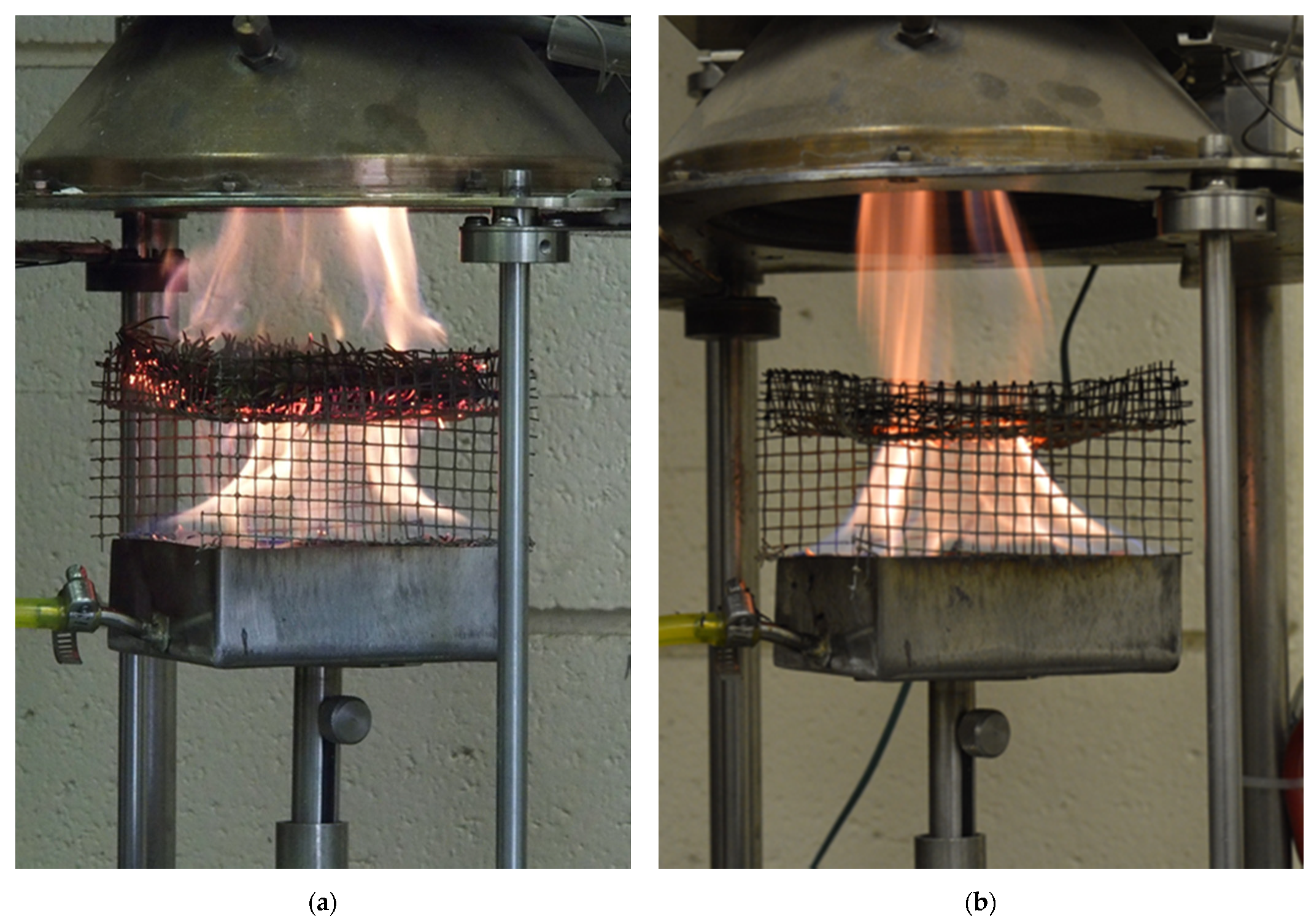
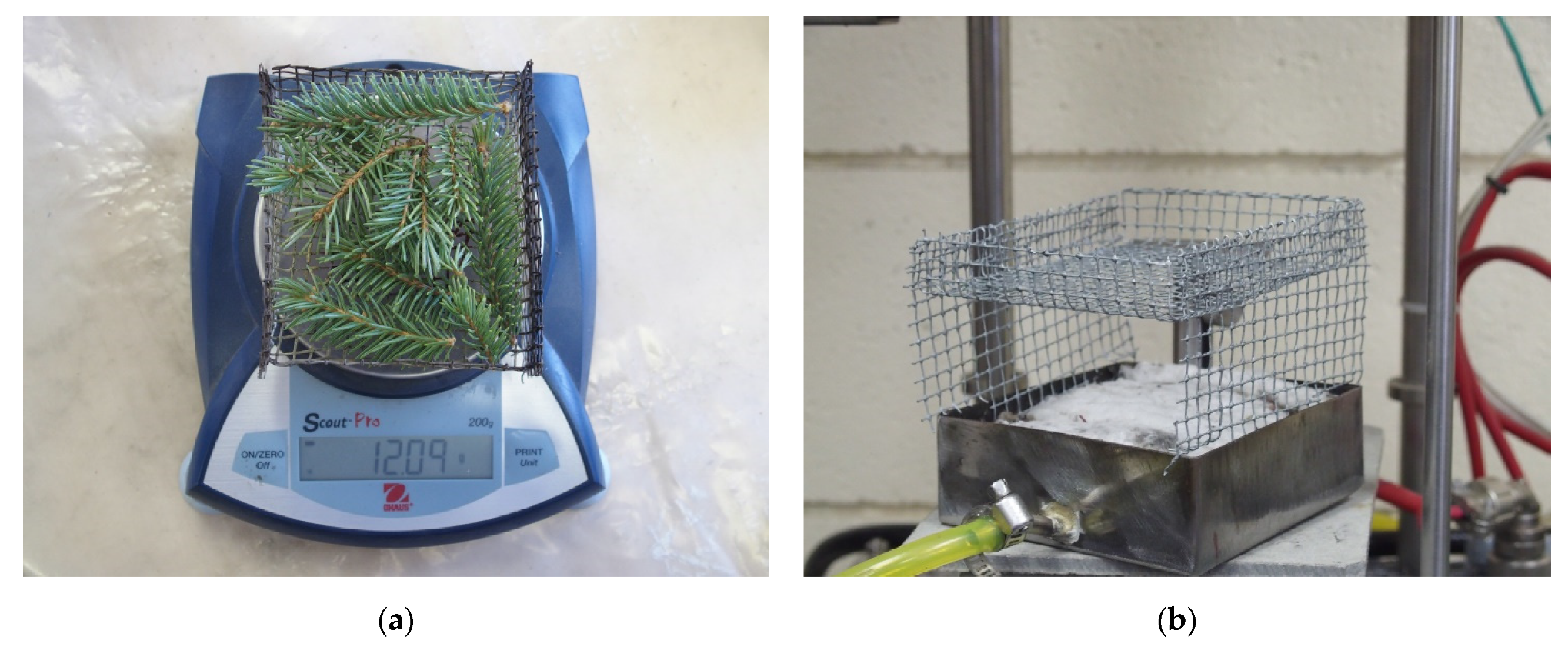



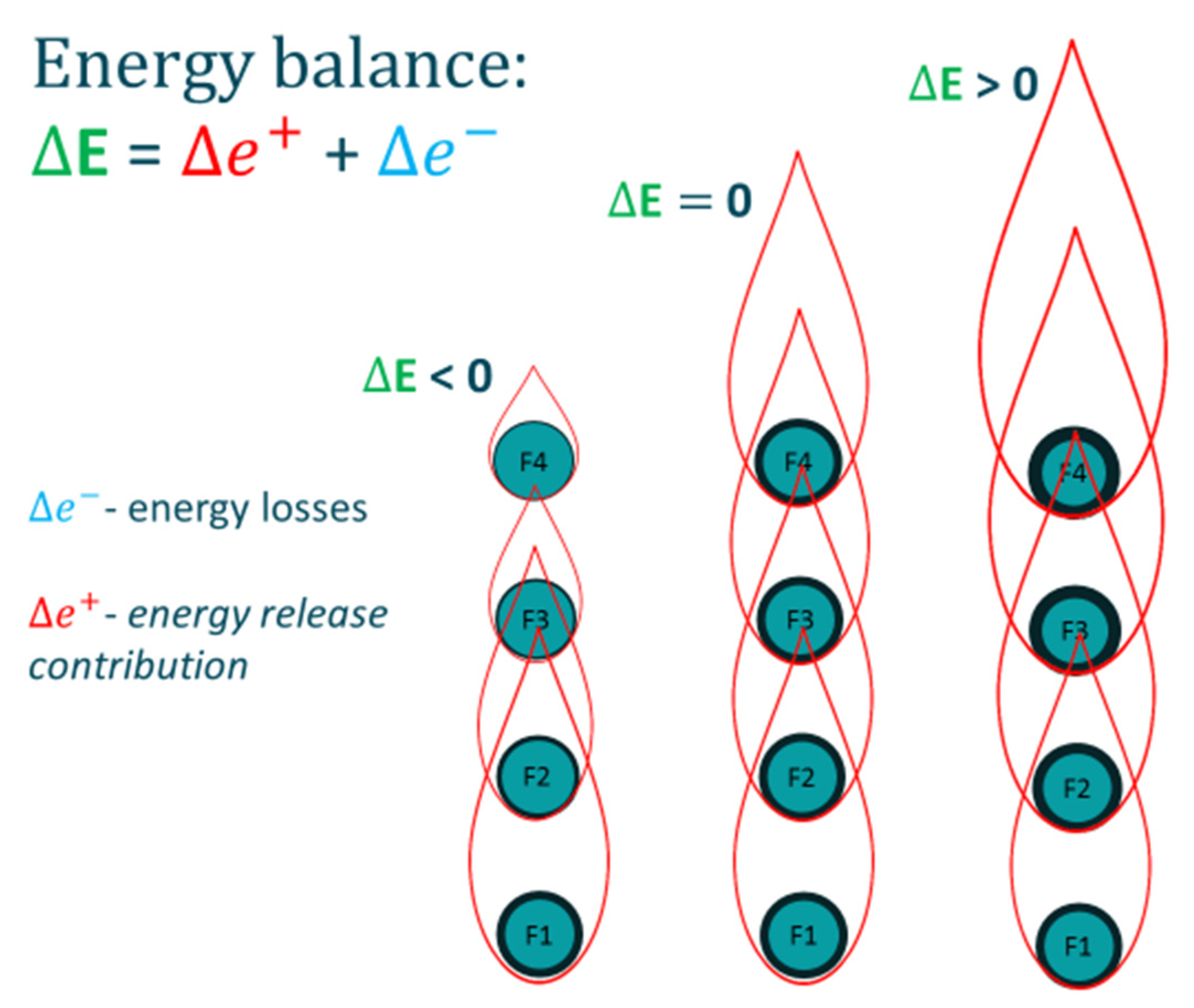
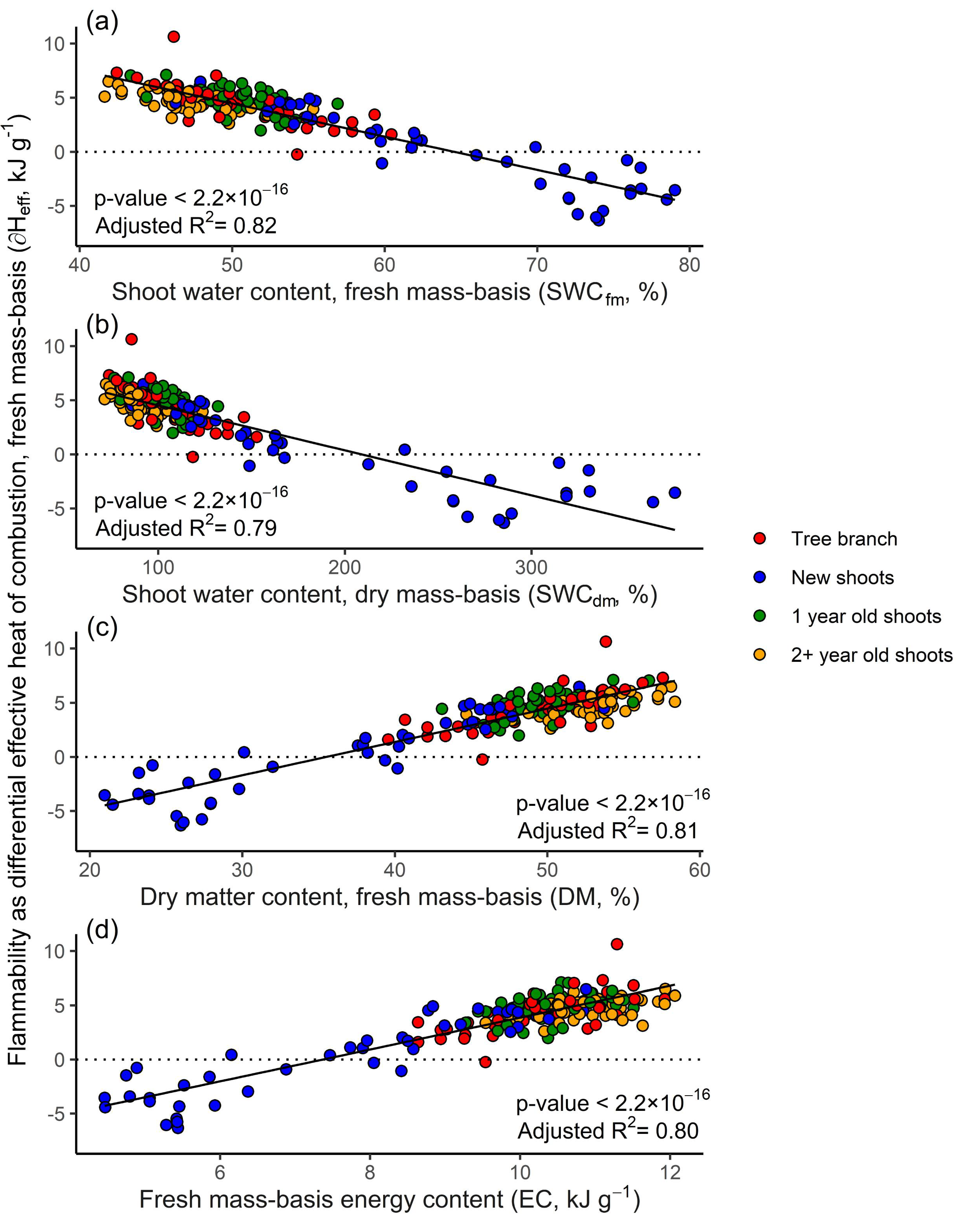

| Recording ID | Preheating Start Timestamp (h:min:s or s) | Preheating/Ignition Delay Time (s) | Flame-Front Residence Time (s) | Flame-Front Exposure Time (s) | Source |
|---|---|---|---|---|---|
| Plot 3 Part II | 03:10:40 | 19 | 53 | 72 | [62] (video) |
| Video 3 | 04:32:47 | 23 | 35 | 58 | [63] (video) |
| Video 4 | 04:32:58 | 18 | 29 | 47 | [63] (video) |
| Video 5 | 04:32:53 | 21 | 29 | 50 | [63] (video) |
| Video 6 | 04:32:51 | 13 | 38 | 51 | [63] (video) |
| Video 7 | 04:32:36 | 24 | 38 | 62 | [63] (video) |
| Sensor height 13.8 m | 530 | 35 | 30 | 65 | [56] |
| Sensor height 12.3 m | 520 | 50 | 25 | 75 | [56] |
| Sensor height 9.2 m | 535 | 35 | 20 | 55 | [56] |
| Sensor height 6.2 m | 540 | 35 | 30 | 65 | [56] |
| Sensor height 3.1 m | 535 | 50 | 25 | 75 | [56] |
| Average | 29 | 32 | 61 |
| Plant Tissue Type | Minimum | Maximum | Range | Mean (Standard Deviation) | Sample Size | ||||
|---|---|---|---|---|---|---|---|---|---|
| EC | ∂Heff | EC | ∂Heff | EC | ∂Heff | EC | ∂Heff | ||
| Tree branch (mixed shoot) | 8.64 | −0.24 | 11.93 | 10.63 | 3.29 | 10.87 | 10.27 (0.81) | 4.39 (1.79) | 47 |
| New shoots | 4.46 | −6.33 | 10.88 | 6.48 | 6.42 | 12.81 | 7.55 (2.07) | 0.23 (3.68) | 42 |
| 1 year shoots | 9.27 | 1.98 | 11.51 | 7.10 | 2.24 | 5.12 | 10.37 (0.52) | 4.75 (1.19) | 48 |
| 2+ year shoots | 9.54 | 2.61 | 12.06 | 6.49 | 2.52 | 3.88 | 10.92 (0.57) | 4.76 (0.86) | 48 |
| All ages of shoots combined | 4.46 | −6.33 | 12.06 | 7.10 | 7.60 | 13.43 | 9.70 (1.89) | 3.38 (3.03) | 138 |
| Predictor | R2 for Flammability (Predictand) as Fresh Mass Basis ∂Heff, New Approach | R2 for Flammability (Predictand) as Mass Loss Basis ∂Heff, Old Approach |
|---|---|---|
| Shoot water content, fresh mass basis (SWCfm) | 0.82 | 0.80 |
| Shoot water content dry mass basis (SWCdm) as analog of FMC, but for shoots instead of just foliage | 0.79 | 0.78 |
| Shoot dry matter content, fresh mass basis (DM) | 0.81 | 0.80 |
| Shoot fresh mass basis energy content, (EC) | 0.80 | 0.77 |
| Shoot gross heat of combustion dry mass basis (Hgross), or calorific content | −0.005 | −0.002 |
Publisher’s Note: MDPI stays neutral with regard to jurisdictional claims in published maps and institutional affiliations. |
© 2021 by the authors. Licensee MDPI, Basel, Switzerland. This article is an open access article distributed under the terms and conditions of the Creative Commons Attribution (CC BY) license (https://creativecommons.org/licenses/by/4.0/).
Share and Cite
Melnik, O.M.; Paskaluk, S.A.; Ackerman, M.Y.; Melnik, K.O.; Thompson, D.K.; McAllister, S.S.; Flannigan, M.D. New In-Flame Flammability Testing Method Applied to Monitor Seasonal Changes in Live Fuel. Fire 2022, 5, 1. https://doi.org/10.3390/fire5010001
Melnik OM, Paskaluk SA, Ackerman MY, Melnik KO, Thompson DK, McAllister SS, Flannigan MD. New In-Flame Flammability Testing Method Applied to Monitor Seasonal Changes in Live Fuel. Fire. 2022; 5(1):1. https://doi.org/10.3390/fire5010001
Chicago/Turabian StyleMelnik, Oleg M., Stephen A. Paskaluk, Mark Y. Ackerman, Katharine O. Melnik, Dan K. Thompson, Sara S. McAllister, and Mike D. Flannigan. 2022. "New In-Flame Flammability Testing Method Applied to Monitor Seasonal Changes in Live Fuel" Fire 5, no. 1: 1. https://doi.org/10.3390/fire5010001
APA StyleMelnik, O. M., Paskaluk, S. A., Ackerman, M. Y., Melnik, K. O., Thompson, D. K., McAllister, S. S., & Flannigan, M. D. (2022). New In-Flame Flammability Testing Method Applied to Monitor Seasonal Changes in Live Fuel. Fire, 5(1), 1. https://doi.org/10.3390/fire5010001








